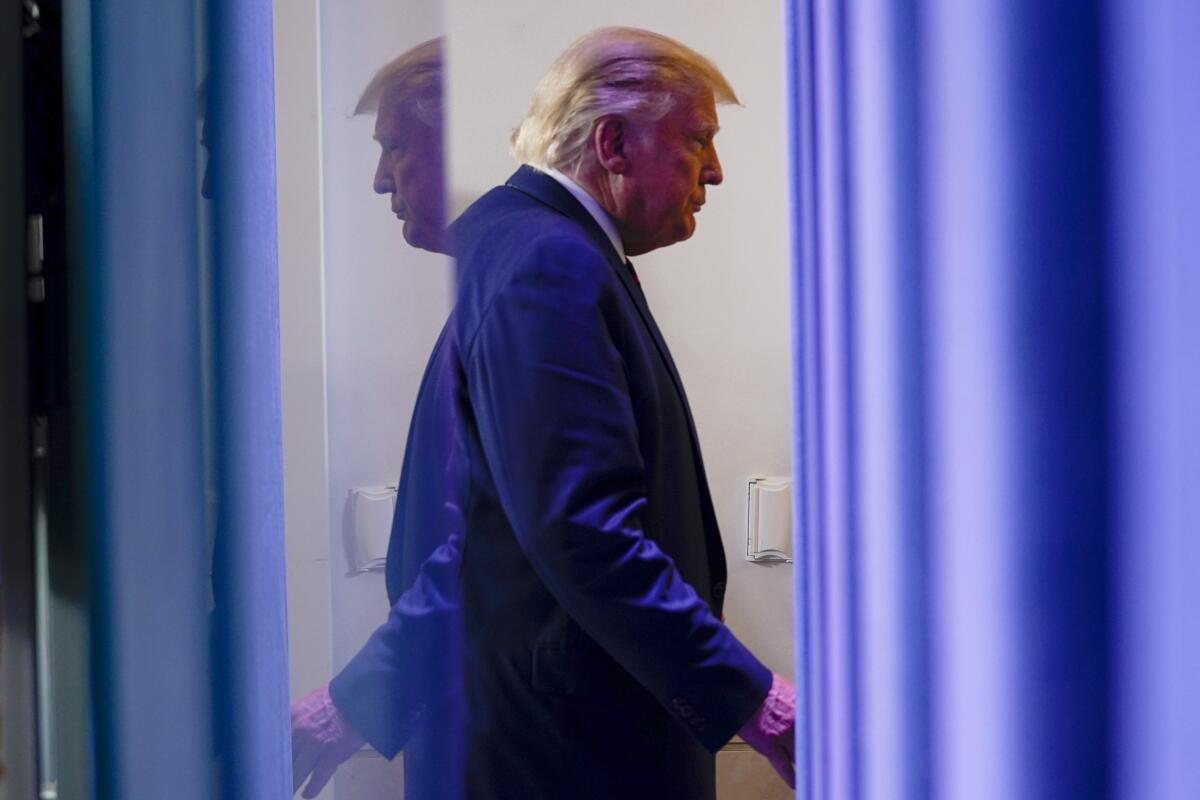Column: How Trump can win

WASHINGTON — President Trump’s campaign for a second term has stalled.
In public opinion surveys, he has trailed Democratic nominee Joe Biden, sometimes by a wide margin, for more than a year. His share of support from voters has been below 45% for six months. No incumbent president in half a century has won reelection from so far behind.
The most recent estimate by FiveThirtyEight, a forecasting group, gives Trump a 29% chance of winning — a bit less than one in three. But as it happens, 29% is the same probability FiveThirtyEight gave a Trump victory just before the 2016 election, when he defeated Hillary Clinton.
So Trump has beaten the odds before. And this time, he has two advantages that he didn’t have four years ago: the powers of incumbency and a massively funded campaign that’s already flooding battleground states with television advertising.
“Biden has an advantage at the moment,” Republican pollster David Winston told me. “But there are clearly things Trump can do to move things forward.”
The president has a clearly defined strategy, and it comes in three parts.
First, he’s trying to discredit Biden, painting him as too weak to be an effective president.
The first version was “Sleepy Joe,” but that attempt to paint Biden as mentally feeble didn’t stick. Then it was “Puppet Joe,” but arguing that Biden is controlled by left-wing extremists didn’t fit either.
In a television interview last week, Trump even charged (without evidence, of course) that Biden was using performance-enhancing drugs — the only possible explanation, the president claimed, for his opponent’s ability to give a lucid speech.
The president’s attacks may seem scattershot, but they’re designed to reinforce a common theme: Trump is strong; Biden is weak. The tagline in some of Trump’s campaign ads makes that explicit: “Strong leadership when America needs it most.”
A second line of attack is law and order: Trump has tried to capitalize on violence in several cities by warning that a Democratic victory would make Americans more vulnerable to crime.
“You won’t be safe in Joe Biden’s America,” the president has warned — ignoring the fact that the current disorders arose three years into his own presidency.
It’s a classic conservative pitch, similar to a theme Trump sounded successfully in 2016, and it’s aimed mainly at two audiences. One is Trump’s voting base of white working-class voters; some of the president’s advisors believe they can lure more of them to the polls by sharpening the culture war. The other target is people who voted for Trump in 2016 but have drifted away since, especially suburban women and older voters.
This argument hasn’t created a detectable increase in support for Trump, but it has succeeded in increasing voters’ worries about crime. A Quinnipiac poll in Florida last week found that “law and order” had risen to second place in a list of voters’ top concerns, behind the troubled economy but ahead of the coronavirus that is on track to kill 200,000 Americans by election day.
Trump’s third front — and perhaps the most important — is a drive to reshape voters’ view of reality on the two points where he is most vulnerable: his record on the pandemic and the economy.
“The two central issues are defeating the virus and getting America working again — not only getting the economy going, but getting kids back in school,” Winston said. “Voters want to hear solutions to those problems.”
The president’s economic pitch is straightforward: He’s seizing every sign that the economy has begun to recover from its pandemic-induced recession to argue that prosperity is just around the corner.
On Friday, it was the news that unemployment fell to 8.4% in August, its fourth consecutive month of decline from a peak of 14.7% in April, when it was the highest since the Great Depression in the 1930s.
Even more audacious, Trump is arguing that the pandemic is coming to an end — and claiming that he deserves credit for ending it.
The pandemic, alas, isn’t over — as Trump’s own public health aides acknowledge. In fact, it’s worsening in some states, killing nearly 1,000 Americans a day. But that hasn’t deterred the president from urging voters to behave as if it is.
Not only is he trumpeting every step toward a vaccine as if a cure were already in hand; he’s talking and acting as if the danger of COVID-19 has passed, urging states to reopen their economies and schools.
Only Democrats, he suggested, stand in the way of everyone living a normal life.
The next step, strategists in both parties suggest, will be a not-very-surprising October surprise: an announcement from the White House that an experimental vaccine is ready for distribution or (if regulators dig in their heels) almost ready.
Home-bound Americans crave good news, and any sign of a breakthrough, no matter how premature, could give Trump’s reelection prospects a boost.
Will it be enough to pull Trump over the finish line?
He’s well behind Biden, and the fundamentals — a deadly virus and millions out of work — still stand in his way. But if Trump catches a few breaks — if the Food and Drug Administration grants emergency authorization for a vaccine, if the pandemic ebbs, if the economy bounces back, if Biden stumbles — this could be a very close election.
Just like the one that sent him to the White House in 2016.
More to Read
Get the L.A. Times Politics newsletter
Deeply reported insights into legislation, politics and policy from Sacramento, Washington and beyond. In your inbox three times per week.
You may occasionally receive promotional content from the Los Angeles Times.











